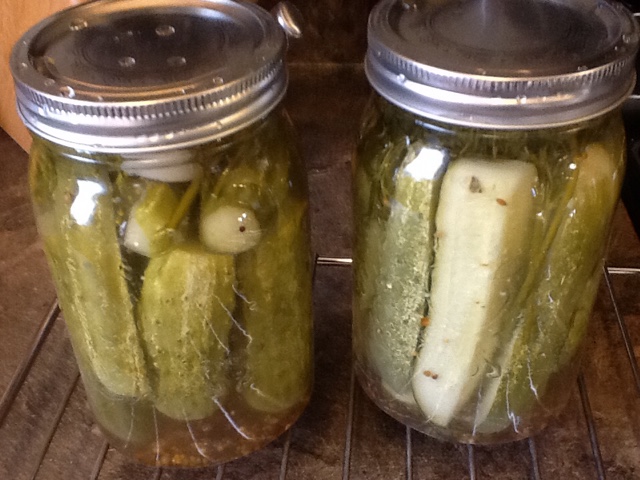Another 30lbs of tomatoes, what to do? How about some home made, organic tomato soup, of course! I used the recipe from
http://www.pickyourown.org/tomatosoup.htm but there are a few on the Internet that sounded good. One caution however, I wouldn't add flour as a thickener, as it would throw off your acid balance and could cause problems in the longevity of your preserved food.
So, here we go. Once again, it's important to start with clean equipment, and sterilize jars properly. I used the sterilize feature on my dishwasher for the jars and rings, and boiled the lids ahead of time.
It seemed to take an awfully long time to bring 30lbs of tomatoes to a boil. About two hours, on med-high heat. I actually had to switch to a larger pot and move to the propane burner outside because there were so many tomatoes! Once everything was in the pot and happily bubbling away, I let it simmer for an extra half hour to help the flavours come together, and thicken the soup a little more. My immersion blender took care of the skins and most of the seeds, but there were still a few left in the pot when I was done. Extra fibre, I guess.
I could only process 7 quarts at a time, but in the end it will be worth it. 13 jars altogether, with 4 good size servings per jar. I'm appreciating my pressure canner a little more every day. :)
The Recipe:
30lbs ripe tomatoes, cored and quartered.
6lbs onions, chopped
1 head of garlic, minced
2 cups sugar
3tbsp salt
1 cup chopped fresh basil
Lemon juice, 2tbsp per quart jar
1. Working with about a bowlful at a time, add tomatoes to a huge pot with a little water to keep them from sticking. Bring to a boil.
2. As the tomatoes boil, continue adding tomatoes a bowl at a time. Stir often, pushing down the floaters into the boiling liquid, until all the tomatoes are added.
3. Add the onion and garlic, and continue boiling until the onions are soft, about 30 min.
4. Remove from heat. Working a small amount at a time, use an immersion blender or food mill to make your soup all smooth. If you don't want the seeds you will need to strain them out with a coarse strainer. If you use a fine mesh strainer, not only will you end up removing a lot of the pulp, but it will take you FOREVER and a day. I was lazy and left mine in.
5. Put your monster pot back on the heat, and bring it back to a boil. Add the sugar, salt, and basil, to taste. I added the whole 2 cups, and I think it will be a little sweet in the end. The sugar is meant to accentuate the sweetness of the tomatoes, not overpower them, and to offset the acid that gets added to each jar.
6. Add 2tbsp lemon juice to each jar. This is an important step as it ensures that the food is acidic enough to be preserved for longer than a few days. Once the lemon juice is in, ladle in the soup, leaving 1/2" of head space.
7. Put on the lids, and rings, finger tight. Process in a pressure canner, 20 minutes @11-13 lbs pressure for a dial-gauge style canner. Tomatoes are a low-acid food, right on the verge of what would be safe for a boiling water bath process, so it's better to be safe than sorry. No botulism for me, please. (Although, perhaps I could harvest the spores somehow and sell my toxin for injection purposes?)














